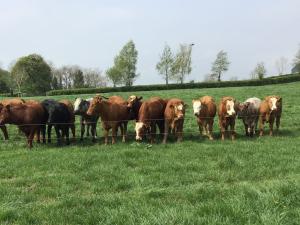Soil and nutrient management for optimal forage production on beef farms
Date published:
For beef farmers in Northern Ireland, “grass is your greatest asset”, providing a cheap, highly nutritious feed for livestock.

Optimising the production of high quality grass can reduce reliance on concentrate feeds and result in both economic and environmental benefits. The average beef and sheep farm in Northern Ireland currently produces 4 to 7 tonne of grass dry matter per year (t DM/ha/yr), but much more is achievable, with well managed swards producing in excess of 12 t DM/ha/year.
That being said, if farms have low stocking rates, increasing fertiliser usage across all farmland to produce more grass is likely to be unnecessary and wasteful. Instead, it is very likely that fertiliser usage only needs to be increased on the better well drained areas of land used for cutting, and where risk of nutrient loss in surface run-off is least. This will mean that the area of land needed for forage production and requiring high inputs of nutrients is kept to a minimum. This in turn will save money and reduce the environmental footprint of the farm.
Managing soil and optimising nutrient inputs is key to improving grass production. While nitrogen (N) is the most important nutrient for grass growth, managing it can be challenging. Anywhere between 30% and 50% of applied N can be lost from soil before it can be utilized by swards. Greatest N losses usually occur in the first 3 to 5 days following slurry or fertiliser N application. Using low trajectory slurry spreading techniques such as trailing shoe, and avoiding spreading slurry or fertiliser if heavy rain is forecast within the following 48 hours, can minimise N losses to water as nitrate, and nitrous oxide or ammonia-N losses to the atmosphere.
On the other hand, in periods of extended summer drought, such as was experienced in 2018, grass growth can stop temporarily and it is important that no N fertiliser or slurry is applied during these very dry spells. If fertiliser N has been applied during drought conditions, much of it will likely remain in the soil undissolved. While this undissolved fertiliser may be available for sward uptake when the ground receives some light rainfall again, if there are heavy and persistent periods of rain, there is greater risk of N leaching into local water ways.
For less intensive beef farms, soil phosphorus (P) requirements will be lower than for more intensively managed farming systems. In Northern Ireland there has been a tendency to over-apply P, with a result that 25% of grassland soils used for beef and sheep production now contain excessive levels of P (Index 2+ or greater). Where manure N inputs are less than 120 kg N/ha/year and chemical N inputs are on average 60 kg N/ha/year, a soil P Index of 2- should be the target for grazed fields, with a higher target of 2+ for silage fields.
With regard to extensive grazing, in most cases it should be possible to meet the P requirements of extensively managed swards using slurry alone, without applying any fertiliser P, which is highly vulnerable to run-off into nearby streams and rivers.
Farmers should also be aware of the need to monitor potassium (potash) (K) and sulphur (S) levels in soil, especially in silage fields. Deficiencies in K and S are common across Northern Ireland, and very frequently inadequate applications of K and S are the cause of sub-optimal grass production. Soil should be sampled every 4-5 years, and beef farmers should aim for a soil K index of 2- in grazed fields and 2+ in silage fields. It is also recommended that S should be applied routinely in spring to all swards, both grazed and cut, using an S-containing fertiliser (< 10% SO3), to prevent sulphur deficiency.
Finally, maintaining soil pH between pH 6.0 and 6.2 through regular liming will increase the use efficiency of all nutrients and has the potential to improve yields by up to 2 t DM/ha/year. Applying lime little and often, every 4-5 years rather than leaving large gaps of 10 years or more is advised. The extra grass produced as a result of liming potentially will provide a 5-fold return on the lime investment.
In summary, farmers should regularly soil sample to ensure the nutrient demand of their grassland is matched to expected production. The adoption of applying best practice to nutrient management will improve profitability on the farm while also minimising environmental losses.
Notes to editors:
AFBI is an arms-length body of DAERA delivering research and development, diagnostic and analytical testing, emergency response capability and expert scientific advice for DAERA and other government departments, public bodies and commercial companies in Northern Ireland, and further afield.AFBI’s Vision is “Advancing the Local and Global Agri-Food Sectors Through Scientific Excellence”.AFBI’s core areas:Leading improvements in the agri-food industry;Protecting animal, plant and human health;Enhancing the natural and marine environment.